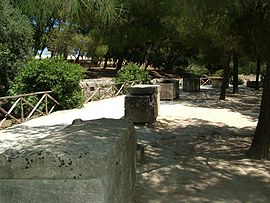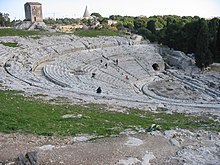Parco Archeologico della Neapolis
The Parco Archeologico della Neapolis or Parco monumentale della Neapolis is an archaeological park in Syracuse , Sicily .
This park includes the Greek Theater, the Sanctuary of Apollon Temenites, the Roman Amphitheater, the Altar of Hieron II, the Latomia del Paradiso, the Latomia Intagliatella, the Latomia di S. Venera and the Necropolis Grotticelle.
General
The park was created between 1952 and 1955. It is located in the north-western part of the city. The park also includes the small church of S. Nicolò dei Cordari from the 11th century.
Latomia del Paradiso
Latomies are ancient stone quarries . Today the Latomia del Paradiso quarry is a deep garden. In the times of the Greeks, these were artificial caves. The construction workers of the time used the limestone from the depths because it was easier to work with. Large caves were created, which were supported with pillars made of abandoned material. Probably in the 16th century, the vaults collapsed in an earthquake.
In the northwest of the Latomia del Paradiso is the Ear of Dionysius , an artificial grotto 65 m long, 23 m high and 5 m to 11 m wide. It got its name because of its shape, which resembles a human ear, and because of the phenomenon that sound intensifies in the grotto. Excavations brought the remains of a Demeter sanctuary to light on the plateau above the grotto. The amplification of the sound was probably used for religious purposes.
Nearby is situated Seiler cave ( Grotta Cordari ) which is closed since 1987 as stone shock. For this reason, the entrances to the Latomia Intagliatella and the Latomia di S. Venera are also closed.
Altar of Hieron II.
Opposite the Latomia del Paradiso is the altar of Hieron II , of which only the part hewn out of the rock remains. The other parts of the altar were used as building material for Spanish fortifications in the 16th century. The altar was built between 241 and 215 BC. Built in BC. The dimensions of 198 m × 22.8 m correspond to the dimensions of a stadium .
Greek theater
Since the 5th century BC The existence of a theater is documented. But it was probably not the theater now being seen. The theater is very flat, it is only 19.1 m high. The diameter is 138.6 m. The theater was carved out of the rock. The stage building was three stories high. In front of it there was a retractable wooden stage, in front of which another narrow wooden stage could be built. The cavea (spectator stand) was divided into nine parts, each part belonged to a member of the ruling family, with a statue of Zeus in the middle .
The Romans rebuilt the theater considerably. The stage building was set back and the 17th row of seats removed. The arena was enlarged and protected with a grille.
Others
In the north on a terrace directly above the theater there is a grave road that is 150 m long. Here were pictures of the ancestors and the heroes. In the middle of the street of tombs is the Grotta del Ninfeo, a Nymphaion , the source of two aqueducts was fed, it was with statues of the Muses decorated. In Spanish times, the water from the grotto was used to operate several water mills , one of which has been preserved to the west of the theater. The other smaller grottoes on Gräberstrasse are of Christian origin. Above the theater was the sanctuary of Apollon Temenites, of which only remains are left, it gave the hill its current name.
The Roman amphitheater was built in the 3rd century. On the way to the theater there are sarcophagi from Syracuse and Megara Hyblaea from the 4th and 3rd centuries BC. With an area of 140 m × 119 m, the amphitheater is one of the largest in the Roman Empire, the arena measures 70 m × 40 m.
The necropolis Grotticelle, west of the Latomia di Santa Venera at the end of the park, dates from the 7th century BC. Christ. Here is an elaborately designed grave site, which is called Archimedes' tomb , but it is a columbarium from Roman times.
literature
- Brigit Carnabuci: Sicily. Greek temples, Roman villas, Norman cathedrals and baroque cities in the center of the Mediterranean (= DuMont art travel guide ). 6th, updated edition. DuMont Reiseverlag, Ostfildern 2011, ISBN 978-3-7701-4385-6 .
- City of Syracuse leaflet
Web links
Coordinates: 37 ° 4 ′ 30 ″ N , 15 ° 16 ′ 40 ″ E






